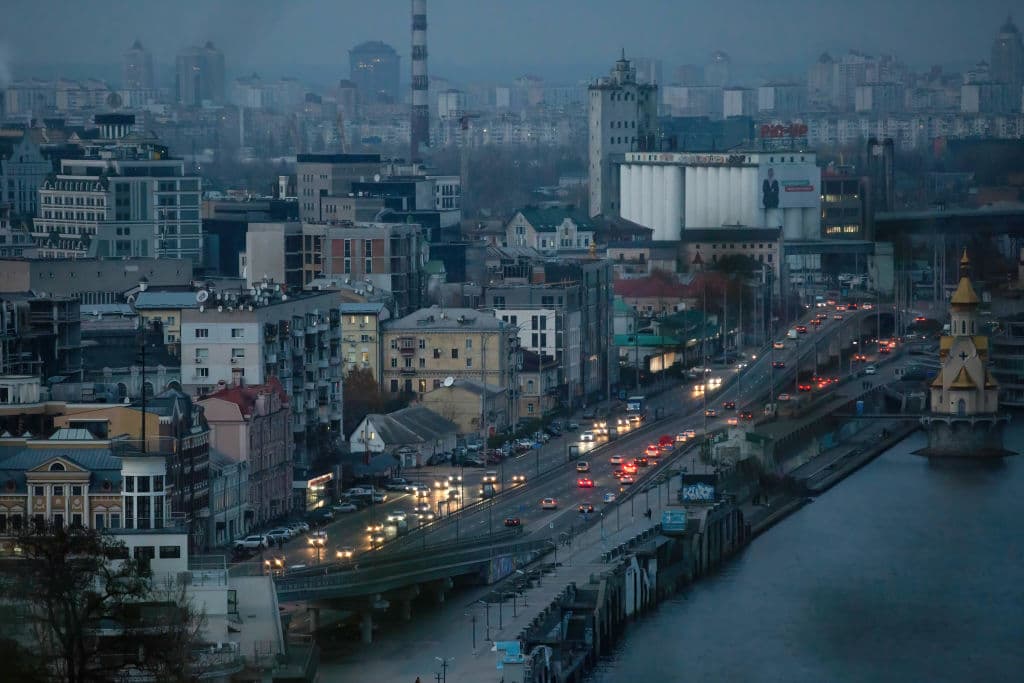Ukraine war latest: Almost all big thermal, hydroelectric power plants damaged, says grid operator

Key developments on Nov. 22:
- US to provide Kyiv with $4.5 billion direct budget support, EU gives $2.5 billion for reconstruction.
- Russian forces kill 8 people, injure 16 in past day, according to President’s Office.
- General Staff reports that Russia has lost 85,000 troops in Ukraine since Feb. 24.
After a series of Russian mass missile strikes on Ukraine’s energy infrastructure, practically all big thermal and hydroelectric power plants in the country have been damaged, according to Volodymyr Kudrytskyi, the head of Ukraine’s state grid operator Ukrenergo.
Russia has been targeting Ukraine’s critical infrastructure since early October, admitting that the country’s energy facilities are its primary goal. According to the Geneva Conventions, attacking vital public infrastructure is a war crime.
Kudrytskyi said on Nov. 22 that the level of damage to the energy system is “colossal” and, therefore, scheduled blackouts remain in place to maintain the balance and prevent the “collapse” of the energy system.
Moscow launched its largest missile attack on Ukraine’s energy infrastructure on Nov. 15, causing emergency power outages across the country. According to the Ukrainian authorities, Russian forces launched around 90 missiles at targets across Ukraine that day.
Following the attack, Prime Minister Denys Shmyhal said almost half of Ukraine’s energy system was out of order.
In October, Deputy Prime Minister Iryna Vereshchuk suggested that Ukrainians residing abroad should remain outside the country until spring due to the increased threat of Russian attacks during winter.
“Russia has turned to terrorizing the civilian population,” she said.
US to provide Kyiv with $4.5 billion direct budget support, EU gives $2.5 billion for reconstruction
The U.S. announced on Nov. 22 it would provide Ukraine with $4.5 billion as direct budget support. According to Treasury Secretary Janet Yellen, the funds will begin to be disbursed in the next few weeks.
“The funds will help Ukraine defend against Russia’s illegal war by bolstering economic stability and supporting core government services,” she said.
These services include “wages for hospital workers, government employees, and teachers, as well as social assistance for the elderly and vulnerable,” Yellen added.
The Treasury Department said this payment would bring total U.S. direct budget assistance to Ukraine to $13 billion, all in grants.
“In addition to providing economic support, the U.S. government will continue to use all of our tools, including our historic sanctions coalition, to weaken (Russian President Vladimir) Putin’s war machine,” the statement reads.
On the same day, European Commission President Ursula von der Leyen said on Nov. 22 that the bloc had disbursed another $2.5 billion for Ukraine’s reconstruction.
According to the official, the EU plans to provide a total of $18 billion to Ukraine in 2023.
The funds would be used to cover “urgent repairs and fast recovery leading to a successful reconstruction,” von der Leyen said.
“We will keep on supporting Ukraine for as long as it takes,” she added.
At the International Expert Conference on the Recovery, Reconstruction, and Modernization of Ukraine on Oct. 25, President Volodymyr Zelensky said the country urgently needs $ 17 billion for reconstruction.
“Ukraine literally needs (the funds) to survive,” he said then.

The damage caused by Russian attacks on Ukraine’s infrastructure has reached $127 billion as of late October, according to the Kyiv School of Economics.
However, since then, Russia has launched several large-scale attacks targeting Ukraine’s energy infrastructure, meaning that the actual worth of damage could be higher.
Russia’s losses
The General Staff of Ukraine’s Armed Forces reported on Nov. 22 that Russia had lost 400 troops in the past day, bringing the total number of troops lost since the start of the invasion of Ukraine to 85,000 military personnel.
At the same time, Russia is facing a shortage of high-precision weapons, including Iskander ballistic missiles, according to the data published by Defense Minister Oleksii Reznikov.
Moscow has 119 Iskander missiles left in stock compared to 900 before the start of the full-scale invasion of Ukraine. Russia also has 229 Kalibr cruise missiles left compared to 500 as of Feb. 23.
According to the data, Moscow still has 347 3M-55 Onyx missiles, 6,980 S-300 missiles, and a total of 801 air-launched missiles of various types.
“(There are) four enemies of the Russian missile arsenal: brilliant Ukrainian air defense forces, incompetent Russian forces, sanctions, and time,” Reznikov wrote on Twitter.
Ukraine’s Military Intelligence said on Nov. 12 that Moscow and Tehran were preparing a draft agreement on the supply of Iranian ballistic missiles to Russia.
Attacks and casualties
Russian forces attacked a humanitarian aid distribution point at a school in Orikhiv, Zaporizhzhia Oblast, Governor Oleksandr Starukh reported on Nov. 22. A social worker was killed, and two people were injured due to the attack.
In the liberated southern city of Kherson, Russian attacks killed three people, Oleksandr Leshchenko, the head of the civil protection department of the Kherson City Council, told Suspilne media outlet.
According to Suspilne, 12 sites have been hit in Kherson as of 3:30 p.m. on Nov. 22.
Russia has repeatedly been striking the civilian infrastructure in the city on Nov. 21-22, according to multiple reports by local officials.
Ukraine liberated Kherson on Nov. 11 after eight months of Russian occupation.
Earlier on Nov. 22, Deputy Head of the President’s Office Kyrylo Tymoshenko reported that three people were killed and ten wounded in Kherson Oblast.
He also said that four people were killed and four injured in Donetsk Oblast, and one person was killed and two were wounded in Kharkiv Oblast.












